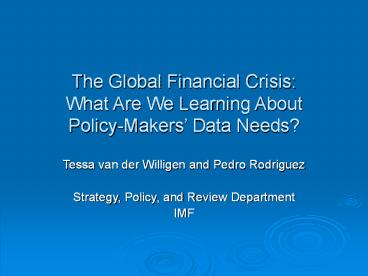The Global Financial Crisis: What Are We Learning About Policy-Makers - PowerPoint PPT Presentation
Title:
The Global Financial Crisis: What Are We Learning About Policy-Makers
Description:
The Global Financial Crisis: What Are We Learning About Policy-Makers Data Needs? Tessa van der Willigen and Pedro Rodriguez Strategy, Policy, and Review Department – PowerPoint PPT presentation
Number of Views:196
Avg rating:3.0/5.0
Title: The Global Financial Crisis: What Are We Learning About Policy-Makers
1
The Global Financial Crisis What Are We
Learning About Policy-Makers Data Needs?
- Tessa van der Willigen and Pedro Rodriguez
- Strategy, Policy, and Review Department
- IMF
2
Outline
- What happened
- Short-term actions
- Better early warning in future
- Data needs
- Disclaimer I may stray outside SNA proper, but
balance sheets are key...
3
What Happened?Background
- Macroeconomic conditions
- Low global interest rates, reflecting large
external surpluses in key emerging markets and
easy monetary policy - Very large increases in asset prices
- Financial sector regulation
- Rapid growth in subprime mortgages in US
- Repackaging into traded structured products
4
What Happened?The Crisis
- Correction in the US housing market
- Fall in, and increased uncertainty in, the price
of structured products - Financial institutions
- made losses and sold assets
- began to hoard liquidity because of increased
uncertainty (about values and counterparties) - reacted sharply to the collapse of Lehman Brothers
5
What Happened?International Linkages
- Origins of the crisis in the US
- Spillovers to Europe because of direct exposures
and declines in wholesale funding - Emerging markets hit after the collapse of
Lehman - The decoupling hypothesis was probably always
optimistic - Accelerated deleveraging
6
Getting the Crisis Under Control--I
- Restoring confidence in mature financial systems
- Providing short-term liquidity
- Removing damaged assets from banks balance
sheets - Recapitalizing banks
7
Getting the Crisis Under Control--II
- Dealing with capital flow reversals in emerging
markets - Use reserve buffers
- Liquidity support (swap lines with major central
banks, the IMFs new Short-Term Liquidity
Facility) - Adjust as necessary
- Review contingency plans in case of banking
sector problems
8
Getting the Crisis Under Control--III
- Addressing the fiscal consequences of
intervention in the financial system - Ensure debt sustainability
- Develop an exit strategy
9
Better Early Warning in Future--I
- Better financial stability analysis
- Risks were moved to off-balance sheet vehicles
- Risks moved to a burgeoning superstructure of
complex marketable products and derivatives and
became untraceable
10
Better Early Warning in Future--II
- Better macroeconomic analysis
- Need better identification of asset price bubbles
- Need a better understanding of how concerned we
should be about external imbalances - (e.g., the discrepancies between the development
of US foreign assets and its current account)
11
Better Early Warning in Future--III
- International financial linkages
- We had far too little idea of countries
exposures to other countries, different kinds of
institutions, and different kinds of instruments
12
Data NeedsFiscal
- Accurate and transparent recording of
- the fiscal costs of intervention in the banking
sector and implications for public debt - contingent liabilities
13
Data NeedsFinancial Sector
- A big agenda for regulators
- Related, we also need better aggregate financial
stability analysis - Considerable efforts in recent years
- Balance sheet analysis
- (the IMFs Standardized Report Forms for Monetary
and Financial Statistics cover banks, non-bank
depository corporations, insurance companies,
pension funds, investment funds, special purpose
entities, etc.) - Financial Soundness Indicators
- (Coordinated Compilation Exercise though these
are lagging indicators)
14
Data NeedsFinancial Sector, Ctd.
- Importance of information on
- Off balance sheet entities
- Contingent exposures (derivatives)
- Maturity of liabilities and assets
- Intrasectoral exposures/market structures
- Valuation
15
Data NeedsExternal Sector
- We need
- better analysis of the buildup of external
vulnerabilities and - better analysis of the potential for
international spillovers through the financial
sector. - Again, considerable efforts in recent years
- initiatives on debt and reserves data after the
Asian crisis - Balance of Payments Manual 6th edition, with more
emphasis on the International Investment Position
(IIP) and its composition (e.g., maturity,
currency) - Coordinated Portfolio Investment Survey
- Coordinated Direct Investment Survey
(forthcoming)
16
Data NeedsExternal Sector, Ctd
- IIP
- Sectoral composition
- Geographical composition
- Currency composition (incl. of reserves)
- Expand CPIS (key countries not covered, annual
frequency, long lags) - Valuation issues, esp. of FDI
17
Conclusion
- Some themes that may be relevant for SNA
- Balance sheets are indeed crucial
- We need not just their amounts but their
sensitivities to various developments (for stress
testing) - Off balance sheet and contingent exposures are
crucial - Aggregation can mask important features
- Valuation issues are very difficult

